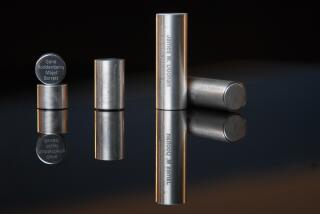Robert C. Truax dies at 93; rocket pioneer aided daredevil Evel Knievelâs 1974 canyon jump
Robert C. Truax, a retired Navy captain and pioneering rocket engineer whose adventurous projects included working with daredevil Evel Knievel and building a rocket in his backyard, has died. He was 93.
Truax died of prostate cancer Sept. 17 at his home in Valley Center, Calif., said his wife, Marisol.
FOR THE RECORD:
Robert Truax obituary: The obituary of rocket pioneer Robert C. Truax in the Sept. 30 LATExtra section said he received a degree from the Naval Academyâs postgraduate school. He received the degree from the Naval Postgraduate School in Monterey. â
He interacted with such scientific luminaries as Robert Goddard and Wernher von Braun and developed concepts that led to high-profile projects such as the Polaris submarine missile and the militaryâs pre- NASA space programs, but he might be best known for building a steam-powered rocket for Knievelâs 1974 attempt to clear the Snake River Canyon in Idaho, then trying to prove space travel could be affordable by building his own rocket in the early 1980s.
âWhat distinguished him was his visionary sense,â Rick Sturdevant, deputy director of history for the Air Force Space Command at Peterson Air Force in Colorado Springs, Colo., told The Times. âIâve had numerous rocket engineers tell me that a lot of Bobâs ideas were ignored because they were too far out of the box, but that didnât mean they were naive or unworkable.â
Truax had âan absolute passion for rockets,â his son Scott said in an interview. âRockets were in the forefront â everything else was a distant second. You could say it was a healthy obsession.â
Robert Collins Truax was born Sept. 3, 1917, in Gary, Ind., the younger son of Alida and Darwin Truax. The family soon moved to Northern California because of his motherâs health problems. By the time Truax graduated from Alameda High School in 1933, he already was a âspace cadetâ who built rockets from tooth-powder cans, he told The Times in 1985.
He entered the U.S. Naval Academy and graduated with a bachelorâs degree in mechanical engineering in 1939. During World War II, he served on the aircraft carrier Enterprise, then led a team that developed the first liquid-propellant takeoff-assist units for naval aircraft.
Truax earned a bachelorâs degree in aerospace engineering at the Naval Academyâs postgraduate school in 1952 and a masterâs in nuclear engineering at Iowa State University in 1953.
In the 1950s, Truax was on loan to the Air Force, for which he worked on the Thor missile project and the first Air Force satellite program. He also served as president of the American Rocket Society, a group started in 1930 to advance the concept of manned spaceflight.
He retired from the military in 1959 and joined Aerojet General in Sacramento, developing the Sea Dragon, a reusable, sea-launched rocket. He also continued work on steam-powered rockets that eventually led him to Knievel. By 1967, Truax was president of his own company.
The motorcycle daredevilâs 1974 jump was a media event. Knievel had become a celebrity by courting danger with elaborate motorcycle jumps, but the attempt to get over the 1,700-foot-wide canyon was by far his most dangerous and most lucrative. A headline from a 1974 Times article said Knievel would âmake a killing â or kill himself.â
He survived the jump but didnât make it over the canyon. News accounts said a parachute opened too early, affecting the flight of Truaxâs âSkycycle.â
âTechnically, he made it over the canyonâ but was blown back by a 15-mph headwind, said William Sprow, a consultant to Edwards Air Force Base and Johns Hopkins University who started working for Truax in 1959.
Sprow said they knew of the wind issues but that Knievel couldnât delay the launch because of the commitment to televise the event. Knievel died in 2007.
By the 1980s, Truax turned to building a rocket in the backyard at his home in Saratoga, Calif. His plan was for a 25-foot rocket that would send a volunteer into suborbital flight of at least 60 miles up. He believed space travel could be more affordable and that spacecraft could be reusable.
âUltimately, he saw our future in space, and the only way weâre going to get there was to make it affordable,â his son Scott said.
Truax had trouble finding enough money to complete the project, but received plenty of media attention, including an appearance on the âTonight Show.â
âYou think itâs going to work?â host Johnny Carson asked Truax, who didnât hesitate with his answer.
âYou bet itâs gonna work,â he said.
In addition to his wife, Truax is survived by four children from his first marriage to Rosalind Heath Schroeder, which ended in divorce: Ann Fleming of Lincoln, Calif., Gary Truax of Berkeley, Kathleen Truax of Sonoma and Steven Truax of Sacramento; two children from his second marriage to Sally Sabins, who died in 1993: Dean Truax of Vancouver, Wash., and Scott Truax of Willard, Utah; seven grandchildren; and 16 great-grandchildren.
Services will be private.
More to Read
Start your day right
Sign up for Essential California for the L.A. Times biggest news, features and recommendations in your inbox six days a week.
You may occasionally receive promotional content from the Los Angeles Times.





